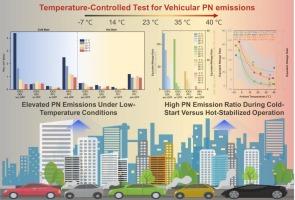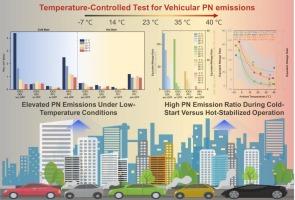Overlooked crisis: cold temperature amplifies particle number emissions from gasoline vehicles
IF 9.7
1区 环境科学与生态学
Q1 ENVIRONMENTAL SCIENCES
引用次数: 0
Abstract
This study systematically investigates particle number (PN) emissions from light-duty gasoline vehicles through chassis dynamometer (60 emission test runs spanning −7 °C to 40 °C) combined with mechanistic analysis, revealing a severely underestimated “cold-temperature penalty” effect. While gasoline direct injection (GDI) engine technology improves fuel economy, it significantly amplifies PN emissions, particularly during cold startup mode, where GDI-equipped internal combustion engine vehicles (ICEVs) without gasoline particulate filters (GPFs) emitted PN levels up to 10 times higher than during hot startup operation at 23 °C. GPF installation demonstrated substantial PN reduction benefits, with its emission control efficacy surpassing the motor auxiliary mitigation effect of hybrid electric vehicles (HEVs). Notably, PFI-equipped HEVs without GPFs emitted around 7 times higher PN emissions than PFI-equipped ICEVs with GPFs at 23 °C conditions, challenging the conventional belief that “electrification equals cleanliness”. Additionally, we quantified medium-speed emission migration in HEVs, exposing hidden pollution risks during motor-engine transition. A critical combustion efficiency threshold of 0.99 was identified as a regulatory pivot for the non-monotonic relationship between PN emissions and combustion efficiency, offering a new optimization target for emission control systems. An exponential correlation between equivalent mileage ratio (EMR) and ambient temperature was established, showing that even at 20 °C, GDI-equipped ICEVs without GPFs exhibited EMR values as high as 50, indicating that 1 km of cold-start PN emissions equals 50 km of hot-stabilized operation, highlighting a regulatory blind spot in current emission standards for cold regions. These findings provide scientific insights for combustion optimization and after-treatment design under extreme climates while underscoring the urgency of prioritizing GDI-equipped vehicles without GPFs in emission regulations for cold temperature zones.


被忽视的危机:低温会增加汽油车的颗粒排放量
本研究通过底盘测功仪系统地调查了轻型汽油车的颗粒数(PN)排放(60次排放测试,范围从- 7 °C到40 °C),并结合机理分析,揭示了严重低估的“低温惩罚”效应。虽然汽油直喷(GDI)发动机技术提高了燃油经济性,但它显著增加了PN排放,特别是在冷启动模式下,配备GDI的内燃机车辆(icev)在23 °C的热启动模式下排放的PN水平高达10倍。安装GPF显示出显著的PN减少效益,其排放控制效果超过了混合动力电动汽车(hev)的电机辅助减排效果。值得注意的是,在23 °C的条件下,配备pfi的未配备GPFs的hev的PN排放量比配备pfi的配备GPFs的icev高出约7倍,挑战了“电气化等于清洁”的传统观念。此外,我们量化了混合动力汽车的中速排放迁移,揭示了电机-发动机过渡过程中的潜在污染风险。将燃烧效率临界值0.99作为PN排放与燃烧效率之间非单调关系的调节点,为排放控制系统提供了新的优化目标。建立了等效里程比(EMR)与环境温度之间的指数相关关系,表明即使在20 °C时,未安装gdi的icev的EMR值也高达50,这表明1 km的冷启动PN排放等于50 km的热稳定运行,突出了当前寒冷地区排放标准的监管盲点。这些研究结果为极端气候条件下的燃烧优化和后处理设计提供了科学见解,同时也强调了在寒冷温度地区的排放法规中优先考虑无GPFs的gdi车辆的紧迫性。
本文章由计算机程序翻译,如有差异,请以英文原文为准。
求助全文
约1分钟内获得全文
求助全文
来源期刊

Environment International
环境科学-环境科学
CiteScore
21.90
自引率
3.40%
发文量
734
审稿时长
2.8 months
期刊介绍:
Environmental Health publishes manuscripts focusing on critical aspects of environmental and occupational medicine, including studies in toxicology and epidemiology, to illuminate the human health implications of exposure to environmental hazards. The journal adopts an open-access model and practices open peer review.
It caters to scientists and practitioners across all environmental science domains, directly or indirectly impacting human health and well-being. With a commitment to enhancing the prevention of environmentally-related health risks, Environmental Health serves as a public health journal for the community and scientists engaged in matters of public health significance concerning the environment.
 求助内容:
求助内容: 应助结果提醒方式:
应助结果提醒方式:


